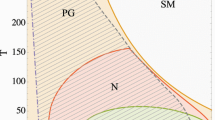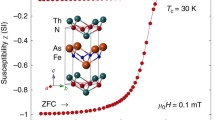Abstract
In this article I give a pedagogical illustration of why the essential problem of high-T c superconductivity in the cuprates is about how an antiferromagnetically ordered state can be turned into a short-range state by do**. I will start with half-filling where the antiferromagnetic ground state is accurately described by the Liang-Doucot-Anderson (LDA) wavefunction. Here the effect of the Fermi statistics becomes completely irrelevant due to the no double occupancy constraint. Upon do**, the statistical signs reemerge, albeit much reduced as compared to the original Fermi statistical signs. By precisely incorporating this altered statistical sign structure at finite do**, the LDA ground state can be recast into a short-range antiferromagnetic state. Superconducting phase coherence arises after the spin correlations become short-ranged, and the superconducting phase transition is controlled by spin excitations. I will stress that the pseudogap phenomenon naturally emerges as a crossover between the antiferromagnetic and superconducting phases. As a characteristic of non Fermi liquid, the mutual statistical interaction between the spin and charge degrees of freedom will reach a maximum in a high-temperature “strange metal phase” of the doped Mott insulator.
Similar content being viewed by others
References
P. W. Anderson, Science, 1987, 235(4793): 1196
P. W. Anderson, P. A. Lee, M. Randeria, T. M. Rice, N. Trivedi, and F. C. Zhang, J. Phys.: Condens. Matter, 2004, 16(24): R755, and references therein
For a review, see: B. Edegger, V. N. Muthukumar, and C. Gros, Adv. Phys., 2007, 56(6): 927
D. Vaknin, S. K. Sinha, D. E. Moncton, D. C. Johnston, J. M. Newsam, C. R. Safinya, and H. King, Phys. Rev. Lett., 1987, 58(26): 2802
A. Auerbach, Interacting Electrons and Quantum Magnetism, New York: Springer-Verlag, 1994
For a review, see: P. A. Lee, N. Nagaosa, and X. G. Wen, Rev. Mod. Phys., 2006, 78(1): 17
Z. Y. Weng, New J. Phys., 2011, 13: 103039; ar**v: 1105.3027, 2011, and references therein
S. Liang, B. Doucot, and P. W. Anderson, Phys. Rev. Lett., 1988, 61(3): 365
W. Marshall, Proc. R. Soc. Lond. A, 1955, 232(1188): 48
For a review, see: Z. Y. Weng, Int. J. Mod. Phys. B, 2007, 21: 773; ar**v:0704.2875, 2007
J. Zaanen and B. J. Overbosch, Phil. Trans. R. Soc. A, 2011, 369: 1599; ar**v:0911.4070, 2009
D. N. Sheng, Y. C. Chen, and Z. Y. Weng, Phys. Rev. Lett., 1996, 77(25): 5102
Z. Y. Weng, D. N. Sheng, Y.-C. Chen, and C. S. Ting, Phys. Rev. B, 1997, 55(6): 3894
K. Wu, Z. Y. Weng, and J. Zaanen, Phys. Rev. B, 2008, 77(15): 155102
J. W. Mei and Z. Y. Weng, Phys. Rev. B, 2010, 81(1): 014507
Y. J. Uemura, J. Phys.: Condens. Matter, 2004, 16(40): S4515
Y. J. Uemura, Physica B, 2006, 374–375: 1
T. Timusk and B. Statt, Rep. Prog. Phys., 1999, 62(1): 61
A. Damascelli, Z. Hussin, and Z. X. Shen, Rev. Mod. Phys., 2003, 75(2): 473
Z. Y. Weng and V. N. Muthukumar, Phys. Rev. B, 2002, 66(9): 094509
Z. Y. Weng and X. L. Qi, Phys. Rev. B, 2006, 74(14): 144518
Z. A. Xu, N. P. Ong, Y. Wang, T. Kakeshita, and S. Uchida, Nature, 2000, 406(6795): 486
Y. Wang, Z. A. Xu, T. Kakheshita, S. Uchida, S. Ono, Y. Ando, and N. Ong, Phys. Rev. B, 2001, 64(22): 224519
P. Ye, C. S. Tian, X. L. Qi, and Z. Y. Weng, Phys. Rev. Lett., 2011, 106(14): 147002
P. Ye, C. S. Tian, X. L. Qi, and Z. Y. Weng, Nucl. Phys. B, 2012, 854[FS]: 815; ar**v:1106.1223, 2011
S. P. Kou, X. L. Qi, and Z. Y. Weng, Phys. Rev. B, 2005, 71(23): 235102
V. J. Emery and S. A. Kivelson, Nature, 1995, 374(6521): 434
Z. Tešanović, Nat. Phys., 2008, 4: 408
J. W. Mei, S. Kawasaki, G. Q. Zheng, Z. Y. Weng, and X. G. Wen, ar**v:1109.0406, 2011
T. C. Ribeiro and X. G. Wen, Phys. Rev. B, 2006, 74(15): 155113
T. C. Ribeiro and X. G. Wen, Phys. Rev. Lett., 2005, 95(5): 057001
Y. Qi and S. Sachdev, Phys. Rev. B, 2010, 81(11): 115129
Z. C. Gu and Z. Y. Weng, Phys. Rev. B, 2007, 76(2): 024501
F. C. Zhang, C. Gros, T. M. Rice, and H. Shiba, Supercond. Sci. Technol., 1988, 1(1): 36
G. Baskaran, Z. Zou, and P. W. Anderson, Solid State Commun., 1987, 63(11): 973
P. W. Anderson, ar**v:1011.2736, 2010
Author information
Authors and Affiliations
Corresponding author
Rights and permissions
About this article
Cite this article
Weng, ZY. Mott physics, sign structure, ground state wavefunction, and high-T c superconductivity. Front. Phys. 6, 370–378 (2011). https://doi.org/10.1007/s11467-011-0220-1
Received:
Accepted:
Published:
Issue Date:
DOI: https://doi.org/10.1007/s11467-011-0220-1




